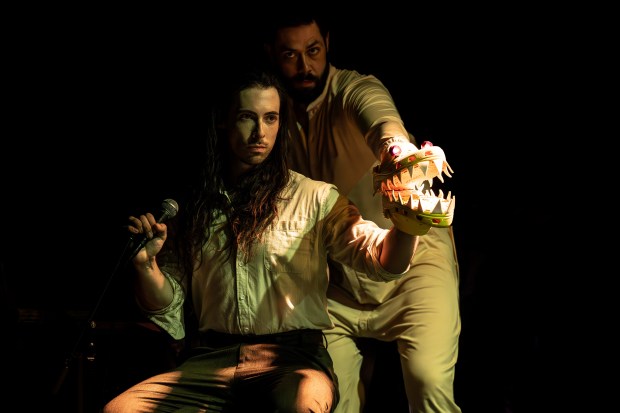There seems to be a surprise around every corner of the Paramount’s “Peter and the Starcatcher” playing through Sept. 1 at the Copley Theatre in downtown Aurora.
And I mean that literally, with almost every square foot of this intimate live performance venue, including the aisles and at times the audience, becoming part of this fanciful, funny feast for the senses.
The biggest challenge: Knowing where your eyes should land.
That’s because in this production, you really don’t know what will pop up – like the floor planks that flip to become trees in a forest. Or a boat deck that morphs into an ocean and then, through the magic of a trunk that sucks in all that waving blue silk, turns into a sandy beach.
Or a crocodile puppet you realize with a quiet chuckle is a pair of Crocs with little spikes attached to the soles of the footwear.
The latter, which might be my favorite prop, was just a “dumb idea that popped in my brain,” admitted first-time Paramount Director Nathan Cohen, who told his team when he threw the thought out there that “I don’t know if I’m serious or not … but I do think I’m serious.”
Props, indeed, go to property designer Ivy Treccani for the way she took that goofy idea and ran with it.
One of her biggest challenges? “Where do you find name brand Crocs in the budget we have that are not $100,” said the 34-year-old Indianapolis native and Northern Illinois University graduate, who joined the Paramount staff in 2019 and in March was made head of the props department.
I bring up this clever use of footwear because it represents a big part of what makes this Paramount production of the whimsical sequel to the story of Peter Pan so special. Not only does this script, written by Rick Elice, contain enough puns to fill a joke book, Cohen and his team added their own pixie dust, if you will, alternating between allowing the audience to see the obvious way something is pulled off to surprising them with the more technical and thus magical moments, most of which take place in Act II on the island of Neverland.
Cohen, an Evanston native now living in Chicago, had planned on doing this play as his thesis production for his Northwestern University master’s degree in fine arts, until COVID came along and shut that dream down.
What has long drawn him to “Peter and the Starcatcher,” he told me, was the narrative itself. Yes, the story, which contains plenty of subplots, is hilarious. But it’s also a touching tale about the power of love, duty and the quest to not only dream but to discover what home really means.
As a director, Cohen told me he’s “interested in plays that ignore the fourth wall” and engage the audience so they too will activate their imaginations.
“One of the big goals of ours for this production was finding the balance of when the actors are enacting the world versus when the world is acting on the characters,” he continued. For example, “when the crew sets sail, you can see the actors making the sails move, pretending to be parts of the ship. But when the boards start jumping up in the jungle, that is something happening to the actors they have no control over.”
When Cohen finally had a chance to take this idea formed six years ago to the Copley stage, the director happily pulled in Megan G. Reavis, a fellow Northwestern theater colleague and friend, as the scene designer.
Reavis is a Miami native now living in New York City who cut her theater teeth on puppetry – her family’s ministry performed at hospitals, migrant camps and the like – which is used not only for the crocodile but also for the ship’s cat, a sea gull, a flock of yellow birds and the winged Tinker Bell.
The puppetry, noted Treccani, was the toughest challenge for a props department that does not specialize in these unique stage characters. Thus, she said, they “were more rudimentary” – think footwear for the crocodile, a mop for the cat – and in my opinion, more amusing.
Reavis saw the Copley space as a “hope chest … of theatrical goodies” that could turn ordinary stage items – like sawhorses, ladders and buckets – into unexpected scene-stealers.
In Act II, however, “starstuff has spilled,” she added. And to reinforce this, “we employed modern technology to blur the lines between simple stagecraft and magic, using flippy floor boards, a ‘sucky uppy’ trunk, LEDs and fiber options with unknown operator origins.”
All of which requires a lot of room for creativity, a big reason why 34-year-old Treccani loves being on staff at the Paramount, and why Cohen and Ravis, also both 34, were thrilled with their time on this production.
“We are so grateful as a team that the Paramount heard our ideas … and drank the Kool-Aid” that allowed so many fun ideas to fly, said Reavis.
One more thing: Even with all this magical stagecraft vying for your attention during this show, you can’t help but notice the talented ensemble who, when not swiftly moving objects around, have created memorable characters, and looked like they’re having the time of their lives playing these outlandish people.
That’s even more noteworthy, I might add, because the lead actors, including the swashbuckling comic villain Black Stache (Nick Sandys) and his pirate sidekick Smee (Mark David Kaplan, winner of three Jeff Awards) are absolutely outstanding.
“It’s complicated,” agreed Cohen when I asked about the effort it took to pull off this must-see (for all ages) production.
Still, no one felt they were biting off more than they could chew, even when the idea popped up to turn faddish footwear into a reprehensible reptile.
“It all created so many opportunities,” summed up Cohen. “It was good fun.”
dcrosby@tribpub.com




